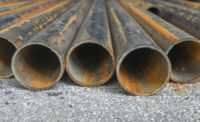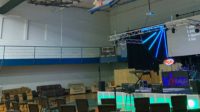As businesses embrace environmental initiatives to combat climate change, facility managers and building operators are feeling pressure to increase building efficiency and reduce energy consumption and operating costs. “Free cooling,” the process of allowing the building load to bypass mechanical cooling and exchange its heat with lower temperature outdoor air, is an environmentally favorable approach that helps reduce operating costs. One emerging solution increasingly available in the marketplace is integrated water-side economizers mounted on air-cooled chillers.
These solutions are often referred to as “free cooling chillers” because the energy use is so low relative to mechanical cooling that it is almost negligible. While not truly “free,” such systems can offer significant energy savings in the correct application. There’s a catch; however, these aren’t one-size-fits-all solutions. These chillers perform differently depending on facility size and location, and effectively applying them into a facility requires understanding the key considerations for optimizing them in order to make integrated free cooling a viable solution.
Determining the most effective free cooling strategies requires taking a myriad of factors into consideration. No one scenario may be perfect, but simulations can help reveal which types of buildings and applications are the most likely to benefit.
Modes of Operation
It's first worth examining the different options buildings have for air-cooled chiller design and usage. Prior to the widespread availability of mounting economizer coils on air-cooled chillers, using separate dry coolers to reject the building heat to the cool outdoor air was a common practice (and one still used today). This practice involves a dry cooler fluid-to-air heat exchanger that receives the building cooling loop glycol directly and then returns it to the building or routes it through the chiller.
In warmer ambient conditions, where the dry cooler is unable to cool the fluid completely, the fluid flows through the chiller to receive mechanical cooling. To control the fluid flow path, valves connecting the building cooling water loop to the chiller and fluid cooler open or close, allowing the flow to bypass the dry cooler or chiller when appropriate, which helps manage pressure drop.
The newer method of integrated free cooling also uses glycol to air coils like a dry cooler does, but these coils are typically attached to the chiller outside of the primary condenser coil to cool the process fluid using low-temperature ambient air. These chillers also typically operate in one of three “modes,” including mechanical, hybrid, and 100% free cooling mode. In mechanical cooling mode, the unit functions just like a normal air-cooled chiller, cooling the glycol using the refrigeration cycle. This happens when the ambient temperature is above the temperature of the glycol leaving the chiller.
With the second mode of operation, “hybrid mode,” glycol first moves through the fluid-to-air coils where it is partially cooled and is then diverted into the evaporator, where it is further cooled via mechanical cooling to meet the design fluid temperature set point. This mode is active when the ambient temperature is below the entering fluid temperature, but not low enough to achieve 100% free cooling. Because hybrid mode operates in mild ambient temperatures, it can often represent the greatest number of run hours. This means that optimizing operation during hybrid mode is crucial for maximizing system efficiency and achieving the best return on investment.
The third mode, 100% free cooling mode, happens when ambient temperatures are well below the leaving fluid temperature — often as much as 20°-30°F (11.1°-16.7°C) lower, depending on the system design. In this mode, all glycol cooling is accomplished by the coils, with the compressors turned off. As a result, this mode draws very low levels of power since only the condenser fans and fluid pumps require electricity.
It is important to understand that integrating free cooling coils onto the chiller does come with some drawbacks. In addition to heavier weight and higher initial cost, there is an efficiency penalty to the mechanical cooling mode. Adding free cooling coils over the existing condensing coils can increase the air pressure drop, causing the fans to work harder and raise the condensing temperature, which can lead to lower mechanical cooling efficiency when compared to a similar chiller without those coils. For free cooling to make sense, there must be enough load in the winter, where free cooling saves tremendous kilowatt usage, to more than offset the summertime efficiency penalty and still provide a reasonable payback period. Evaluating this balance is where building energy simulations can provide tremendous value.
Evaluating the Benefits of Free Cooling: The Scenarios
To evaluate the potential effectiveness of integrated water-side economizer coils for different climates and building types, 365-day building energy simulations are a useful comparative tool. The following simulations covered three prototype buildings across seven climate zones and used the U.S. Department of Energy’s EnergyPlus (version 8.5) total building energy simulation tool to model a chiller plant consisting of commercially available chillers with and without integrated free cooling. The model generated hourly building loads based on typical meteorological year weather data and standard ASHRAE 90.1 inputs for building envelope and lighting power densities.
It is important to remember that studies like this are comparative, so they can serve as good indicators for which applications may be better or worse than other applications. However, actual energy usage and dollar savings values may vary significantly in any given building. These simulations serve as a good starting comparison rather than a conclusive rule.
Hospital Simulation
The first scenario applied integrated free cooling to a hospital application. In this hospital, the chiller runs predominantly in mechanical cooling mode in the summer months and shoulder seasons due to a sizable cooling load and because temperatures are too warm for free cooling. Despite the presence of a wintertime cooling demand, free cooling operation sees limited run hours in this application due to the impact of fresh air ventilation.
Building codes typically require high ventilation rates for hospitals, so cool outdoor air already provides the bulk of the cooling during the colder ambient conditions when hybrid cooling or free cooling would normally be active. As a result, there is relatively little load left to remove using the free cooling function. Conversely, in the summertime, the free cooling coils reduce the efficiency of the mechanical cooling, so the net effect is a higher overall energy use, even in cold climates like Duluth, Minnesota. This highlights one key aspect of chiller integrated free cooling: It provides the best benefits when used in conjunction with an application that has higher wintertime run hours and cannot cost-effectively use air-side economizing to meet the wintertime cooling demand.
Data Center Simulation
The next simulation examined the cooling needs and performance of a relatively small data center, which used chilled glycol to indirectly cool its servers. For this data center, the wintertime load is much higher than the previous hospital scenario because the load is tied to the electrical load of the servers as opposed to being dependent on ambient temperature. Additionally, data centers generally run warmer chilled water temperatures, so more hours of free cooling are available.
This trend can be seen by looking at the varying heights of the red and blue bars in Figure 4. In a location like Miami, because the number of free cooling hours is small, using integrated free cooling results in higher energy use because of the lower use of mechanical cooling. In all other locations; however, simulations showed that integrated free cooling resulted in energy savings, with significant savings noted in moderate to cold climates. For example, in Duluth, the annual energy usage dropped to almost half when using a chiller with an integrated water-side economizer, resulting in more than $50,000 of annual energy savings.
As previously mentioned, it’s important to recognize that in the case of data centers, the chilled water loop leaving fluid temperature is often designed for higher temperatures than those normally used for comfort cooling. While a typical comfort cooling application may use a 44°F (6.7°C) leaving fluid temperature, data centers often use 55°F (12.8°C) or higher, with the most common designs in the 60°-70°F (15.6°-21.1°C) fluid temperature range. This means that free cooling can engage at a relatively higher ambient temperature than comfort cooling applications that use lower leaving fluid temperature designs, leading to a higher number of free cooling operating hours and better payback.
Office Building Simulation
The final simulation evaluated free cooling in a medium-sized office building with a 600-ton comfort cooling load and ASHRAE-standard ventilation rates. The results fell somewhere between data centers and hospitals with less winter load and run hours than a data center but more than a hospital, due to lower ventilation.
In reviewing the results, Atlanta was just under break-even, so climates cooler than Atlanta could expect to see some energy savings in an office-building-type application.
The yearly spend on energy is shown in Figure 6, with the best result seen in Boston, which achieved $12,000 in annual energy savings. Many older buildings and systems may have ventilation rates less than those modeled here, so energy savings in those instances could be even more pronounced.
Tapping into Savings Potential
Overall, these results demonstrate that integrated free cooling can result in significant energy savings when applied to the correct application. For data centers in particular, the energy savings of integrated free cooling during the cooler months far offset the penalty to mechanical cooling efficiency during the warmer months in all but the warmest climates. We can thereby deduce that other applications with similarly high wintertime loads, such as process cooling applications for plastic manufacturing, pharmaceutical production, or food and beverage production, could similarly benefit from integrated free cooling, especially if those applications also use elevated leaving fluid temperatures. Even office buildings and similar comfort cooling applications may see some benefit from an integrated free cooling solution. Due to climate and building differences; however, integrated free cooling may result in more varied results and thus requires more careful consideration.









